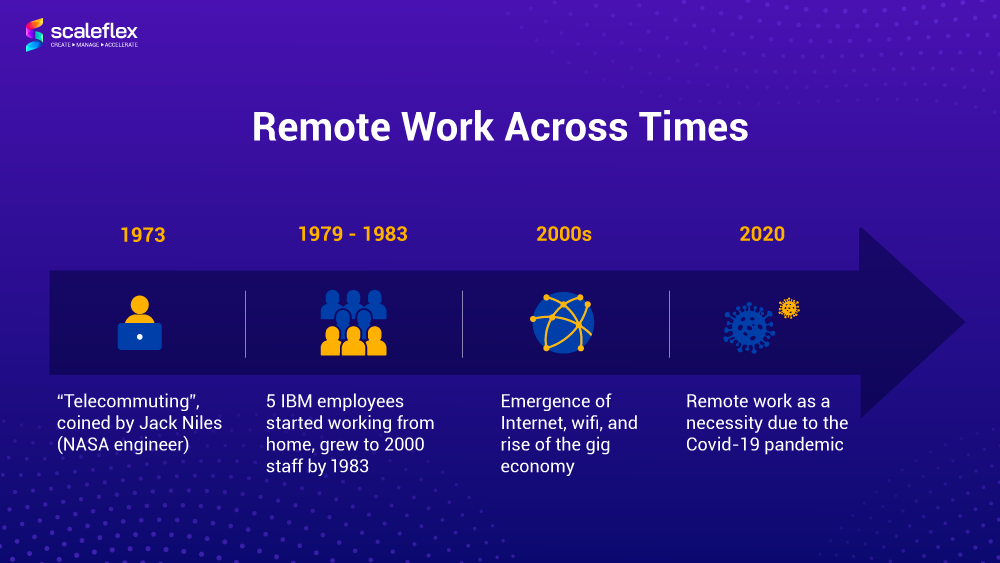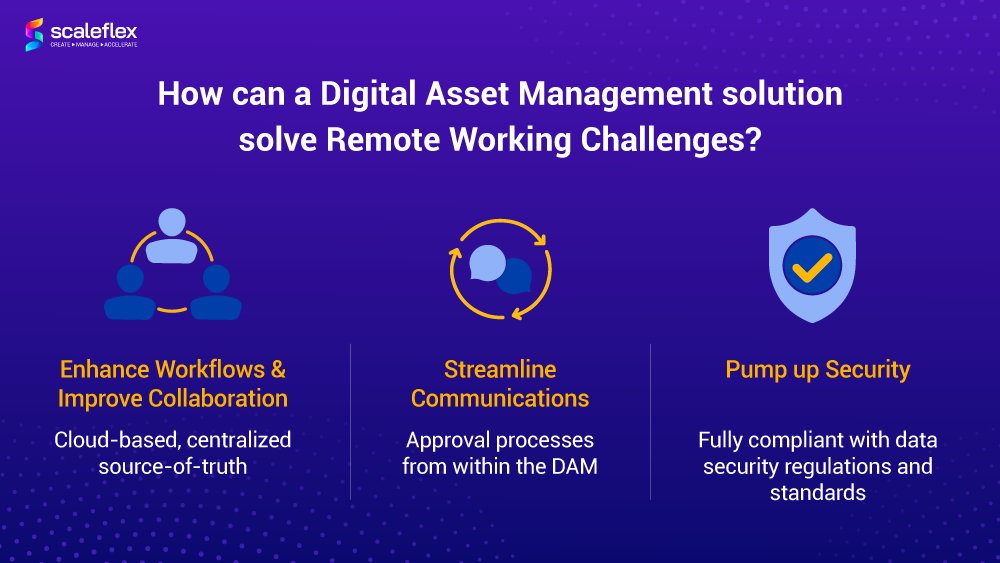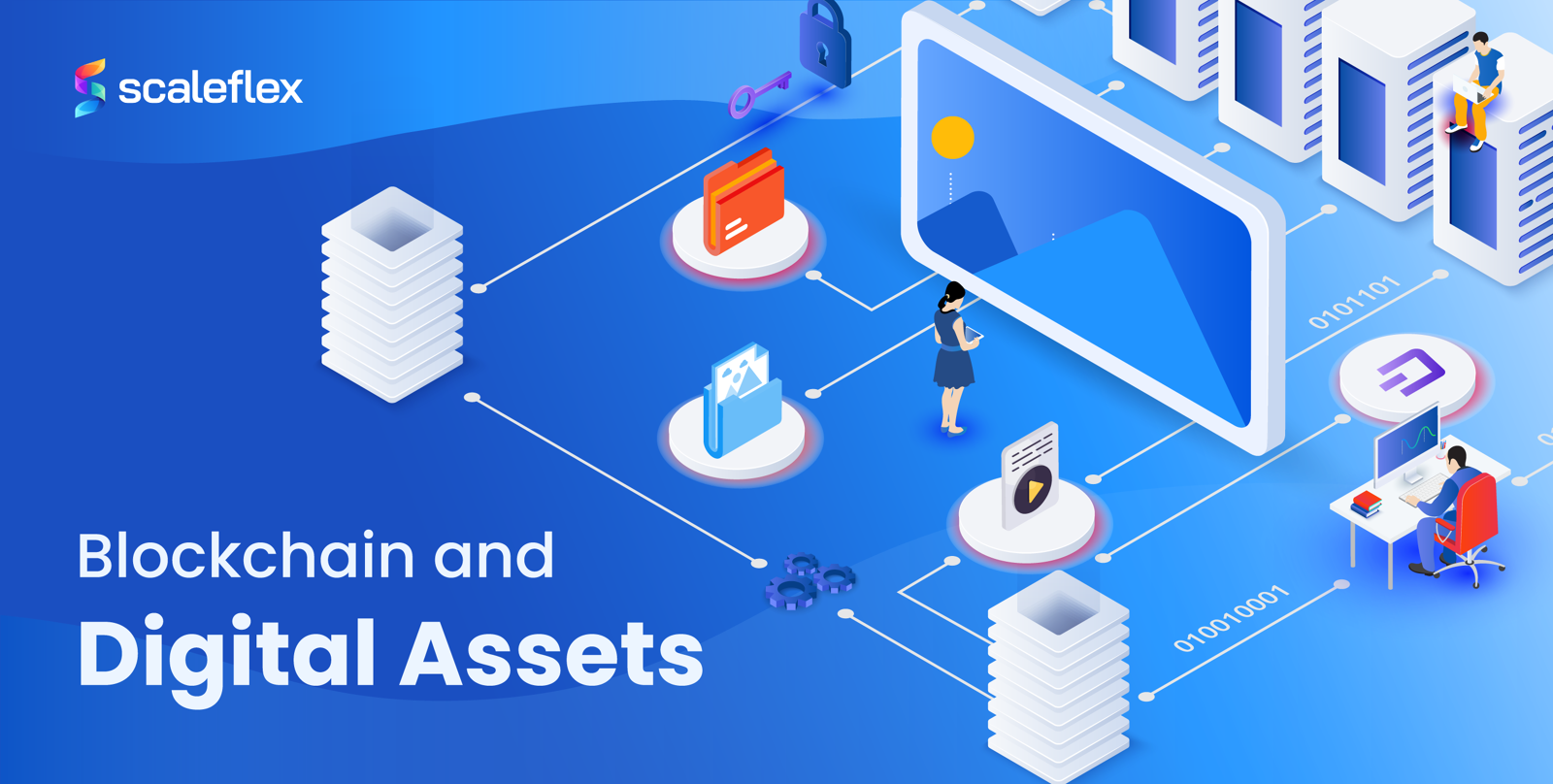Digital Asset Management And Its Role In Remote Work
You’ve probably heard the buzz about remote work, whether due to the Covid-19 pandemic or at Scaleflex or another successful fully remote company. But is remote work the future? Or is it just a stopgap measure to get through a global pandemic?
Of course we acknowledge that face-to-face interactions are still required in many occupations. Yet increasingly, thanks to new technologies and innovations, more occupations are eligible for remote work. Swedish freight tech business, Einride, has developed an autonomous electric transport Pod that enables truck drivers to control and operate several Pods remotely from a single location. Virtual consultations can take place with qualified doctors over an online video call, with your medication delivered to your home shortly after.
Whether it is here to stay or not, remote teams have long been adopted by numerous companies, and they’re going to be an even bigger thing from now on.
Now, what you may not know is that Digital Asset Management (DAM) is one of the most essential remote working tools responsible for the success and efficiency of remote teams. Implementing a DAM into your company’s workflow can help solve numerous hybrid work or work-from-home challenges!
History of Remote Work
Let us look at the remote working origin and development first.
“Telecommuting”, coined in 1973 by NASA engineer Jack Nilles, laid the groundwork for what we know today as remote work.
In 1979, way before remote work tools like Zoom calls and Google Meets, 5 employees at IBM were already working from home to see how efficient remote work was. By 1983, that number grew to 2000.
Then came the emergence of the Internet, Wi-Fi, and the rise of the gig economy in the 2000s, where on-demand workers can be granted access to cloud-based applications, completing short-term or long-term projects outside the office.
Even before the sudden shift to remote work due to the Covid-19 pandemic, some companies were thriving with remote teams. What’s even more surprising is that they are not just tech startups but large, established businesses in various industries, like Microsoft, Dell, Amazon, Gartner, Toptal, to name a few, and certainly, Scaleflex!
The Rise and Popularity of Remote Work in the Post-Covid World
“73% of all teams will have remote employees by 2028.” - Upwork
Working from home is now a necessity for countless companies. If anything, Covid-19 has thrust flexible, alternative, and hybrid working arrangements into the spotlight and made breakthroughs in technological and cultural barriers that have previously prevented remote work. It showed that productive work is possible and paved a structural change in the location where work can occur. Economists in both the United States and Norway have found that close to 40% of jobs can be done remotely.
While we do see some semblance of regaining the times before the coronavirus pandemic in many countries, many companies (where possible) have also made plans to move towards a hybrid or fully remote work arrangement for their employees.
Virtual teams and remote working makes sense — the tools we use to communicate have gotten better, making it easier to stay in touch with coworkers and clients wherever we are. And people are finally starting to realize that being in the office doesn't necessarily mean you're working hard — it just means you're in the office.
Furthermore, remote work has also presented organizations with significant benefits, such as:
- increased productivity and creativity
- reduced overhead costs (utilities, office space, office equipment)
- more efficient collaboration asynchronously
- higher employee engagement rates
- lower employee turnover
- reduces brain drain
- better for the environment by reducing commutes
In fact, a Gartner survey found that remote trends will continue as more than 74% of corporate leaders aim to shift staff to remote positions after Covid-19. For example, LinkedIn, a professional networking site, announced that the business would move towards hybrid operations and allow employees to have the option to work remotely fully.
What are the Challenges of Remote Teams?
Just because remote work is growing doesn't mean that it's easy for companies to implement. Ideally, you want your team to be able to collaborate on projects and share files easily in a secure manner. Yet, there are some top content and workflow challenges the increased percentage of remote workers brought over the past two years.

Difficulty Coordinating Workflows
Compared to work-from-office arrangements where colleagues meet, discuss, and work on projects synchronously, coordinating workflows can be difficult for remote teams, especially if they are settled in different countries across the globe.
Because you cannot see the time your team members put in on a project, it may feel like there is no progress. You may have a team in Seattle, another in New York, and another in London—and they're all working on different deliverables that need to coincide with each other.
Remote working tools that support asynchronous collaboration are necessary to allow team members to work together on projects seamlessly. It's important to use remote work tools that were made specifically for collaboration between multiple parties, so everyone has access to the information they need when they need it.
Poor Communication between Teams
Sometimes there could be a communication breakdown between people working in different locations, especially if you're using software that isn't designed for collaboration. It can be hard to build trust and relationships with people you don't see regularly, so it's important to find ways or remote work tools for your team members to interact even when they're not at work.
Inadequate Security and Privacy Protocols
When you're in the office, you know that there's a dedicated IT team whose job is to keep your data safe. But when you're working off-site and need to share confidential company assets or even just your personal information with someone else on your team, you may not be thinking about best practices for data compliance and cybersecurity.
Remote working teams can pose a challenge for IT managers as they'll need to find the right tools to protect the company's confidential digital assets or customer data.
Sharing confidential company assets between remote teams can expose them to hackers or other third-party interference, resulting in data breaches, which are costly and can damage the reputation of your business. Many companies are legally required to take proper precautions with customer data and ensure that only those who need to see it have access to it.
How can Digital Asset Management benefit Remote Teams?
With so many people working from home, how does a company ensure that collaboration between teams isn't disrupted? How do you track all the deliverables that need to be completed by multiple team members? And most importantly, how do you ensure that confidential files are kept safe when shared?
That's where Digital Asset Management comes in!
DAM is one of the most critical remote working tools for remote workers to collaborate easily and efficiently with their team—accessing those digital assets from anywhere! Companies without a strong Digital Asset Management system are at serious risk of losing track of their assets and processes when they go remote.

Enhance Workflows & Improve Collaboration
DAM provides a cloud-based, centralized file and asset storage system that enables both internal and external stakeholders to search, organize, manage, access, and monitor digital assets efficiently and seamlessly, whenever and wherever they are.
Since everything's on the cloud, you don't have to worry about keeping track of which version is the latest version or accidentally leaving a USB stick full of important photos at home!
The key difference between DAM and cloud-storage providers or other remote work software is that Digital Asset Management solutions come with:
- Customizable metadata and AI tagging during upload, allowing remote teams to save time as they can easily search through large volumes of digital assets efficiently.
- Duplicates management and versioning control, which keeps everything organized and in one place so that everyone has access to the most up-to-date versions of whatever they need at any given time; great as a remote work document management system and saves storage space and bandwidth!
- Strong APIs and integration options, allowing the DAM to play the central role for your digital assets, working with existing platforms and software. DAM helps to remove content silos and reduces the number of remote working tools used daily.
Companies can also look forward to saving time with DAM! Team members don’t have to wait until someone else is available before they can start working on a project or worry about sending large files over WeTransfer. Asynchronous collaboration is one of remote work best practices which brings about increased productivity and fewer delays due to scheduling conflicts.
Streamline Communications
Communication is vital, and why is Digital Asset Management important for remote teams? Rather than referring to lengthy emails and numerous communication tools to collaborate, a DAM helps to streamline communication by enabling approval processes and validation steps all from one central repository. Team members don’t have to rely on other tools and platforms to share feedback, suggestions and validate assets, making DAM one of the most crucial remote working tools.
Pump up Security
With external stakeholders, a DAM provides secure file sharing with role-based access controls. Unlike email attachments that clog up inboxes with duplicates and outdated versions of things (definitely annoying), DAM makes it easy to track and share your digital assets.
DAM solutions comply with high data security regulations and standards to keep your assets secure. At Scaleflex, our FIlerobot DAM is fully compliant with GDPR with data centres in France and other European countries for your storage and processing needs.
Furthermore, add-on features like invisible digital watermarking are available for licensing and rights management.

How can my business implement a DAM?
As every business has unique use cases, it is crucial to assess what your company needs in a Digital Asset Management work from home solution. Who will be your end-users? What is the nature of your business? Do you need features beyond remote work document management, such as image optimizations and CDNs? These can help you determine the level of control you need and the type of DAM that best suits your company.
We invite you to schedule a demo with our Scaleflex Heroes to find out more about how our Digital Asset Management solution, Filerobot, can be a powerful remote working tool for your company!
The Perfect Pair: DAM and Remote
So, what is the future of remote work? Is remote work here to stay? It seems that virtual teams, hybrid and remote work are here to stay and may even be a crucial consideration for many job-seekers. Despite the challenges arising from remote work, there are ways that an organization can ensure that its remote employees are not left behind. Organizations should prioritize enhancing workflows and improving communication within these virtual teams to keep everyone motivated.
The world of work is evolving, is your business?
Overcome the challenges of remote work and embrace the new world of work with a collaborative and performant Digital Asset Management solution - Filerobot!





